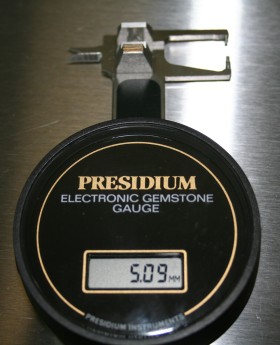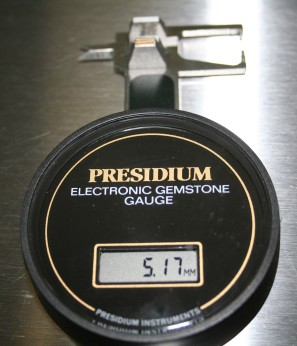Despite the cost and advancements in technology, gadgets such as proportion analysers and The BrillianceScope still have a margin of error built into them that needs to be verified with old fashioned tools such as micrometers.
For example, take this princess cut. The measurements on the GIA certificate said 5.15 x 5.10 mm:
![]()
However, using our proportion analyser, the OGI Firetrace, quite different measurements were produced:
![]()
So, just to check, we used a micrometer:


As you can see, neither of our measurements matched the GIA certificate, and despite freshly calibrating our OGI Firetrace, it still produced those measurements.
As you can see, despite advancements in technology, machines that cost thousands of dollars are still not 100% accurate. In fact, The Brilliancescope manufacturers admit a 5% margin of error. There are however good old fashioned tools such as micrometers and reflection tools (Ideal-Scope, ASET etc) that apply simple science to obtain an exact result every time.
July 20th, 2007 at 6:25 am
Good points.
However, consider the very nature of these machines and metrics will account for a built in and inherent variability which might be scientifically/statistically quantifiable, yet visualy insignificant or negligible, at best.
Regards,
Judah Gutwein
July 20th, 2007 at 12:27 pm
True, but the problem occurs when using such machines over the internet. Such differences may leave customers confused or suspicious about a diamond they’ve never seen in person.
July 20th, 2007 at 11:01 pm
Nikhil,
Obviously, there is no substitute for the eyes. This is why it is important for companies selling diamonds over the net, to offer consumers the ability to either physically view the diamond in person prior to purchase (showroom..etc.), or to return the diamond for a full refund if they don’t fall in love with the stone.
However, I fail to understand the “problem” in using every conceivable scientific metric to evaluate a diamonds beauty, brilliancy and cut precision in tandem with Online selling. True, all of these machines individually, may have certain limitations (including Garry’s Ideal-Scope, BTW, which you clearly believe very strongly in…and which we also use in conjunction with the plethora of info. we provide on our loose diamonds..), however when used together, they offer an incredibly accurate “picture” of how any diamond will perform in real life and upon physical inspection.
If this were not the case, consumers who purchased diamonds Online by means of the info. provided by the MegaScope/Sarin, BrillianceScope, Ideal Scope, HCA, etc., would be returning diamonds in spades once they saw the stone and realized that it did not dovetail with all of the scientific info. that motivated them to buy the stone in the first place.
Fact is, this does not happen, at least not in my experience.
If anything, consumers express the idea that their physical inspection of the diamond completely confirms the information initially seen online from these scientific machines and diamond evaluators.
In my estimation, there is no other way to sell diamonds over the Internet and I think you would agree that today’s educated consumers (especially those who shop on the net) are much more “suspicious” and “confused” when they do NOT have the benefit of this important information at their disposal.
Regards,
Judah Gutwein